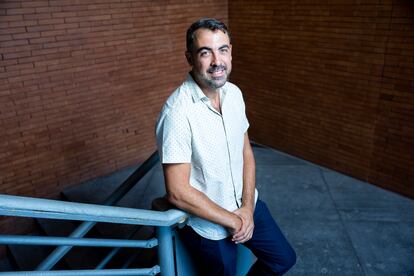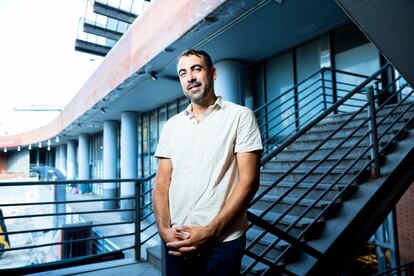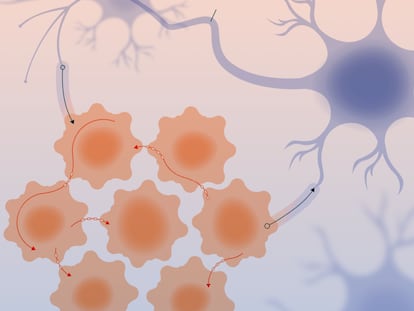Ignacio Sáez, neuroscientist: ‘Our ability to foresee the future and review the past predisposes us to mental illness’
The researcher works with patients with epilepsy to understand the origins of depression, which he aspires to treat with surgery someday

The brain is an extremely complex, hard-to-access organ, two attributes that make it difficult to understand and treat when something goes wrong. Neuroscientist Ignacio Sáez says that there are two fundamental ways to access what the skull protects: “On one hand, non-invasive techniques such as a surface EEG, which allows us to collect information with few complications, but which has many limitations due to the low resolution of the measurements and the knowledge obtained. Then there are the animal models, which allow very precise measurements to be made, but which have evolutionary differences that limit their application to the human brain,” he explains.
However, Sáez does something different in his laboratory at the Icahn School of Medicine at Mount Sinai Hospital, in New York. “My laboratory is working on a technique that allows us to combine the best of both worlds. We work with patients who have surgically implanted electrodes to treat epilepsy or another disease, which allows us to ethically use a very powerful invasive technique that would otherwise be impossible to suggest to try to answer some questions about the human mind,” he continues. With this technique, Sáez wants to understand and treat depression, a project for which he has just received one of the prestigious One Mind Rising Star awards.
The work of this Spanish neuroscientist, who has carried out all his research in the United States, combines knowledge of the nature of human beings and their decisions with the search for a remedy for diseases that have none. “Knowing how cognition or decision-making works, measuring and characterizing these processes, gives us a way to characterize the disease: people with depression do not act or feel the same as a healthy person. This allows us to identify failures in the activation of certain areas of the brain and try to normalize that activity,” he says.
As for the future, he believes that scientists will not stop when they manage to cure brain diseases: “If Alzheimer’s can be treated, why not aspire to create a perfect memory? If an addiction can be treated, why not do something to achieve an iron will?” In a world where men who became millionaires with technology are willing to invest enormous amounts of money in trying to go beyond human limits, in outer space or in delaying aging, neuroscience is the perfect field to shape the future.
Question. You say that people talk about the complexity of the brain, but the complexity of brain diseases is often overlooked. There is a tendency to give simple explanations to these ailments, such as the theory that depression has to do with a lack of serotonin.
Answer. The simplicity of the explanation has a certain beauty: serotonin drops and that causes depression. Many times this is based on observations that are not unreasonable, because the inhibitors we give raise serotonin levels and some people get better. But when you go deeper, you realize that it is never that simple. For example, not all patients with depression respond to these treatments or have the same symptoms, which indicates more complexity.
I believe that this simplistic way of thinking is determined by the way in which we treat these diseases, which is fundamentally pharmacological. We give a drug and that has a systemic effect, which will raise or lower the concentration of a certain molecule in the brain, such as dopamine or serotonin. It’s a very general manipulation. But we know that the impact is not the same in all areas of the brain; for instance, the amount and types of serotonin receptors varies. It’s easy for these simple, beautiful explanations to capture people’s imaginations — and not just the public, but the scientific community as well — and they are a good starting point. But then it’s time to delve deeper and refine our understanding to develop more effective treatments.
Q. How is your approach different?
A. My approach is somewhat the opposite. What I do is anatomically precise, it is based on a surgery in which we implant electrodes very precisely in different areas of the brain, which allows us to measure and modulate their activity independently. Today this is more difficult than giving drugs, more expensive and scarier, but it can become a new approach to treat patients for whom we currently have no solution. Depression is heterogeneous in its presentation and not all patients respond to drugs that raise serotonin levels. We know that there are many variations of depression, which we suspect will not affect the same areas of the brain. To try to treat people accurately, perhaps we should not use a drug treatment that floods the entire brain equally, but something more precise. Our approach opens the doors to a more personalized characterization to then treat each patient accordingly.
Traditionally, the methods we use in human neuroscience are non-invasive and have low resolution, so they are not useful for making observations for each individual patient. Thirty patients are put into a scanner, and with these images an average of areas affected by depression is obtained. This has mean value but does not capture the particularities of two different patients. With invasive surgeries, we can characterize each individual patient.
Another difference in our approach is that we assess brain activity in a disease-relevant context. One of the characteristics of depression is rumination: a healthy person makes a mistake and may regret it, but they learn or forget and move on. Certain types of depressed patients get stuck in that, constantly going back to their mistake without being able to get over it. In our experiments, we force our patients to make decisions that are sometimes wrong, which generates this feeling of regret, in order to measure the neural representation of this signal, which we hypothesize will be greater in depressed patients. This can change from patient to patient, the magnitude or the location, and we would be able to see that a certain area of the brain of a patient is hyperactive and must be controlled, or perhaps the opposite. This is what we would look for with these interventions.
Q. You have access to people with epilepsy or Parkinson’s. Is it possible that they have a different type of depression than someone else who has it because they lost their job or for other reasons?
A. That is one of the limitations. The reason why surgery is done in patients with epilepsy is that epilepsy is sometimes focal; there is an area of the brain where these epileptic seizures are generated and if you locate it and remove it, there is a good chance of curing them. The benefits of that surgery are potentially huge for that person, for the treatment of their epilepsy, but, in addition, 30% or 40% are depressed. This is important because it presents an opportunity to study depression with these invasive methods, taking advantage of the fact that they are going to be operated on for a clinically indicated reason. What is the relationship between epilepsy and depression? Is there a biological relationship, or are the patients unwell because they are epileptic and cannot drive or hold a job? That’s going to be hard to separate. There are clinical trials using similar techniques to treat non-epileptic patients with very severe depression that may shed some light on this question, but they are still in the experimental phase.

Q. How would more people receive this type of depression treatment?
A. In neurosurgery, there is a feeling that we have a tool that works very well for two or three types of diseases; Parkinson’s, for example. We can implant an electrode in a patient with Parkinson’s and revert their symptoms to the state they were 20 years ago. Why aren’t we going to use this tool to treat depression or Alzheimer’s? That question has many answers, but one is that we probably don’t know enough about these other diseases. Perhaps we don’t know where to implant the electrode, or we see that instead of one, we need three. But we are learning to develop more generalizable therapies.
Q. In addition to treatments with surgeries or drugs, is knowledge of the brain helping us identify habits or lifestyles that can be beneficial or detrimental to mental health?
A. At a basic level, you don’t have to refer to the brain to know that some habits are beneficial. You don’t need to know how the brain works or what area is involved to know that exercise is good, because we can see those benefits. It’s not that these observations are useless; on the contrary, they are the starting point for many lines of research. But science is usually a bit behind. For example, we know that exercise is good, and we can start to study why. But the answers are not necessary to adopt good habits, and in many cases they will not change the initial recommendation. But in the popular discourse, and sometimes even in the scientific one, saying that a certain area of the brain is activated when we do something sounds good, even if this often adds little.
Q. Mental illnesses are mainly diagnosed with a questionnaire. Will it ever be possible to have more objective methods?
A. The way we assess mental illness is a problem with a difficult solution. If you ask a person how they are, depending on the moment, they can tell you very different things. There’s what happens to them and then there’s the way they interpret what happens to them. The questionnaires depend on many factors that may not be related to the disease, things like whether or not you have a trusting relationship with your doctor. There is a relatively new discipline, computational psychiatry, which says: I won’t trust what you say, but what you do. I am going to put you in a situation where I will observe your behavior and see if you behave in one way or another. This can be more useful than a questionnaire. We apply it in our way of understanding and studying depression, as it gives us measures that we believe can reflect important aspects of the disease.
Q. Do you envision a world where we can get rid of mental illness?
A. To a certain extent, we are condemned to have diseases like depression. One of the things that humans do better than anyone in the animal world is counterfactual reasoning. It’s the “what if?” That has a significant evolutionary advantage because we are able to do simulations. We use our imagination to think about the future and counterfactual thinking to review the past. Maybe I should have done this, not that. The advantage of this is that it allows you to learn from things you have never experienced; we are thinking about tomorrow and yesterday all the time. This allows you to design an optimal plan of action according to your model of the world, but it comes at a very high price. If you are stuck in your head all the time, thinking about yesterday and tomorrow, you will suffer a lot. When this goes too far it leads to depression and anxiety, for not living in the present. Our ability to foresee the future and review the past predisposes us to mental illness.
Q. Some philosophies, like Buddhism, have developed very sophisticated techniques to stay in the present. Is meditation useful?
A. Yes. If you have depression or anxiety, one of the first things your doctor may suggest is that you meditate. And I believe it is no coincidence that many meditation exercises consist in focusing your attention on the present, avoiding the aforementioned simulations of the past and future. And other healthy habits can have a similar impact and mechanism. What works for me, for instance, are sports. I consider it a form of meditation. When you’re playing soccer or basketball you don’t think about yesterday or tomorrow; you’re thinking about where the ball is, where the other players are, and so on. It forces you to be in the present for a certain amount of time. This exercise is very healthy for many reasons, but one of them is being focused on the present.
Sign up for our weekly newsletter to get more English-language news coverage from EL PAÍS USA Edition
Tu suscripción se está usando en otro dispositivo
¿Quieres añadir otro usuario a tu suscripción?
Si continúas leyendo en este dispositivo, no se podrá leer en el otro.
FlechaTu suscripción se está usando en otro dispositivo y solo puedes acceder a EL PAÍS desde un dispositivo a la vez.
Si quieres compartir tu cuenta, cambia tu suscripción a la modalidad Premium, así podrás añadir otro usuario. Cada uno accederá con su propia cuenta de email, lo que os permitirá personalizar vuestra experiencia en EL PAÍS.
¿Tienes una suscripción de empresa? Accede aquí para contratar más cuentas.
En el caso de no saber quién está usando tu cuenta, te recomendamos cambiar tu contraseña aquí.
Si decides continuar compartiendo tu cuenta, este mensaje se mostrará en tu dispositivo y en el de la otra persona que está usando tu cuenta de forma indefinida, afectando a tu experiencia de lectura. Puedes consultar aquí los términos y condiciones de la suscripción digital.
More information
Últimas noticias
Most viewed
- Reinhard Genzel, Nobel laureate in physics: ‘One-minute videos will never give you the truth’
- Oona Chaplin: ‘I told James Cameron that I was living in a treehouse and starting a permaculture project with a friend’
- Pablo Escobar’s hippos: A serious environmental problem, 40 years on
- Chevy Chase, the beloved comedian who was a monster off camera: ‘Not everyone hated him, just the people who’ve worked with him’
- Why we lost the habit of sleeping in two segments and how that changed our sense of time











































